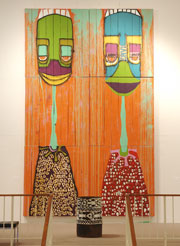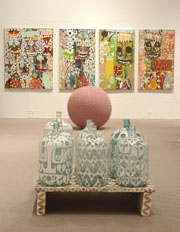|
 |
Installation view
|
 |
Installation view of work in progress
|
 |
| Installation view |
| |
|
Phil Frost: Staking His Claim
back
Mounting a show at the University Art Museum is a kind of homecoming for Phil Frost. A self-taught artist, he began his career in the early 90s by aggressively blanketing New York City’s streets and doorways with strips of brightly colored wheat-pasted posters and exhibiting his paintings alongside other well-known underground artists including, Barry McGee, Mark Gonzales, Margaret Kilgallen, and Mike Mills. But Frost attended Guilderland High School only a few miles from the University; his mother, sister, and a few close friends still live nearby. He remembers visiting the Museum as a teenager and really liking the space; now, fourteen years later, in the Museum’s second-floor gallery—an off-kilter white cube interrupted by a progression of arches, a wall of windows, and a ridiculously high but oddly grand ceiling—Frost brings back his unrelenting energy and his obsessively beautiful vision to stake a temporary claim on the space he remembers.
Frost embraces the world around him in a non-hierarchical manner. The people he meets, the sounds he hears, scraps of paper, nails, sticks, leaves, the occasional dead bird he picks up along the road—all are grist for his artistic mill, and all find their way into his paintings, which are, in his own words, a “culmination of where I am in a particular time or place.” A school desktop riddled with chewed gum; old shovels, footballs, barrels; even barn doors become fertile ground for his hybrid riffs of pattern, color, and texture. Alternating between rough blocks of house-painted surfaces and delicate mantles of correction pen glyphs, Frost creates complex, oscillating surfaces that are at once repetitive and utterly fresh. His choice of color adds further buzz: faded grays, browns, and yellows—the colors of things neglected by time—are punctuated by Day-Glo pinks, oranges, and greens—the colors of 60s psychedelia, Post-It Notes, garage sale stickers, highlighter pens. At the top of his list are crayon box hues, mostly the discontinued ones: maize, goldenrod, magenta, olive green, sea green, sky blue, aquamarine, carnation pink. With each scavenged object, collaged scrap, and offbeat color pick, Frost creates a personal moment in time that belongs as much to the here and now as it does to the past.
There’s an inherent physicality in all of Frost’s work that is rooted in the body, in the dynamics of reach, in the process of working back and forth across space and time. A relentless inscription of his presence over lost ground, this physicality relates directly to his early graffiti work: for example, an ongoing project involves a boulder-sized ball of bakery string that he adds to by rolling it through every space in which he works, hoping that someday the ball will be taller than he is. This calculated determination manifests itself most vividly in the final layer of his recent paintings, a dizzying, elegantly trippy mantle of white correction fluid that inscribes the surface of almost everything he touches, its whiteness a cross between Herman Melville’s abyss and the white flag of surrender.
There’s nothing arbitrary in how Frost arrives at the patterns in his work; they derive mostly from the alphabet. An uppercase “R” is stripped down, the negative space formed by the letter’s intersecting curves and lines is inverted, and the new formation, embellished with a flounce or a curl, is repeated again and again. Whether he is articulating a painting’s picture plane, echoing the curve of a water bottle, or demarcating the seam of a football, Frost doesn’t miss a beat in calibrating his freeform alphabet to fit the space it defines. At once beautiful and illegible, it triggers a host of non-linear associations and unexpected corresponden-ces.
Frost’s ability to resuscitate the arcane and the dog-eared owes much to his idiosyncratic take on art history. When he first moved to New York City he spent his time going to museums, where he formed his preferences for a range of artists and time periods of art history. Of particular resonance is his tough scrutiny of the painted surface and his fascination with the expressive qualities of the portrait bust, evidenced by his admiration of painters Matthias Grünewald, Francis Bacon, and Jasper Johns. Among New York City’s museums, the Metropolitan and the Cloisters remain his favorites. He is most directly inspired by the art of medieval Europe, especially the tapestries, manuscript illuminations, and marginal sculptures that, like his own pieces, reveal an underlying fervor that circumvents the stamp of official art.
Frost’s site-specific paintings fill three of the Museum’s arches. Each work is comprised of a series of rough-cut timber pallets that fit together into a 19- x 12-foot vertical painting. At the top of the Museum staircase, one such painting—two heads with stem-like necks on truncated torsos that sport clown-style collars and heart-and-glyph-patterned blouses—looms over the space. These figures’ quixotic expressions match those of the fourteen figures, painted on barn doors, that flank them on the wall to the right. All belong to the same family of marginal characters that Frost began painting ten years ago. Their elongated, rectangular heads, heavy-lidded bulging eyes, and gap-toothed grins belong, in turn, to visual history’s long lineage of transgressive guardians, representative of those who “know the score” but who hang back and keep watch from the sidelines—Antoine Watteau’s forlorn clown Gils, Bart Simpson, the medieval corbel statues hidden from view above church tympani—all of them the disheveled, exaggerated, unglorified observers of humanity. But Frost’s portraits boldly defy marginalization. Like the artist himself, they have come to roost for awhile in a space they perhaps always meant to occupy.
Corinna Ripps Schaming
Associate Director/Curator
back
|